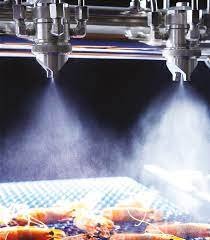Atomization technology is a pivotal innovation that has transformed a multitude of industries by offering efficient and precise methods for converting liquids into fine sprays. This guide will delve into the details of atomization technology, covering its mechanisms, applications, and the numerous benefits it provides. By the end of this article, you will have a thorough understanding of atomization technology and its importance across various sectors.
What is Atomization Technology?
Atomization technology involves the process of breaking down a liquid into fine droplets to create a mist or spray. This technology is essential in many industrial applications, including but not limited to spray painting, fuel injection, pharmaceutical manufacturing, and the food industry. The primary goal of atomization technology is to achieve a uniform droplet size and distribution, which is crucial for the efficiency and effectiveness of the application process.
How Atomization Technology Works
Atomization technology can be achieved through several methods, each with its unique mechanism. The most common methods include mechanical, pneumatic, and ultrasonic atomization.
-
Mechanical Atomization:
This method involves using a high-speed rotating disk or nozzle to break the liquid into droplets.
-
Pneumatic Atomization:
In this technique, compressed air or gas is used to force the liquid through a nozzle, creating fine droplets.
-
Ultrasonic Atomization:
This method employs ultrasonic vibrations to produce a fine mist from the liquid.
Each of these methods offers distinct advantages and is selected based on the specific requirements of the application.
Applications of Atomization Technology
Atomization Technology in Spray Painting
Atomization technology is extensively used in spray painting to ensure an even coating and to minimize paint waste. The fine droplets produced by atomization provide a smooth finish, making it an essential process in the automotive, furniture, and electronics industries.
Atomization Technology in Fuel Injection
In fuel injection systems, atomization technology enhances combustion efficiency by creating a fine mist of fuel. This improves fuel-air mixing, leading to better engine performance and reduced emissions. Modern automotive engines rely heavily on precise atomization to meet stringent environmental regulations.
Atomization Technology in Pharmaceuticals
The pharmaceutical industry utilizes atomization technology in the production of aerosols and inhalers. This technology ensures that medications are delivered in fine droplets, which can be easily inhaled by patients. It is also used in the creation of spray-dried pharmaceuticals, providing uniform particle sizes for better drug efficacy.
Atomization Technology in the Food Industry
In the food industry, atomization technology is employed in the production of spray-dried products such as powdered milk, coffee, and flavorings. This method ensures that the products have consistent quality and extended shelf life. Atomization also helps in the application of coatings on food products, improving texture and taste.
Atomization Technology in Agriculture
Atomization technology is crucial in agriculture for the application of pesticides and herbicides. The fine droplets ensure uniform coverage, reducing the amount of chemicals needed and minimizing environmental impact. This technology helps farmers achieve better crop protection and yield.
Benefits of Atomization Technology
Atomization technology offers numerous benefits, making it indispensable in various industries.
-
Precision:
Atomization technology allows for accurate control over droplet size and distribution, which is essential for achieving desired outcomes.
-
Efficiency:
By reducing material waste and enhancing process efficiency, atomization technology helps lower operational costs.
-
Versatility:
This technology is adaptable to different industries and types of liquids, making it a versatile solution for many applications.
-
Cost-Effective:
Atomization technology minimizes resource usage, which in turn reduces costs associated with materials and production.
The Future of Atomization Technology
As technology continues to advance, atomization methods are becoming more sophisticated, leading to improved performance and new applications. Innovations such as nano-atomization are expected to further enhance the capabilities of this technology. Nano-atomization involves creating extremely fine droplets at the nanometer scale, which can have significant implications in fields like medicine, electronics, and materials science.
Practical Tips for Using Atomization Technology
-
Select the Right Method:
Choosing the appropriate atomization technique is crucial for achieving optimal results. Consider the specific requirements of your application to determine the best method.
-
Maintain Equipment:
Regular maintenance of atomization equipment ensures optimal performance and longevity. This includes cleaning nozzles, checking for wear and tear, and replacing parts as needed.
-
Monitor Droplet Size:
Consistently check droplet size and distribution to maintain quality and efficiency. This can be done using specialized equipment to measure droplet characteristics.
Conclusion
Atomization technology plays a vital role in numerous industrial applications, offering precision, efficiency, and versatility. Understanding how this technology works and its various applications can help businesses optimize their processes and stay ahead in their respective fields. By following best practices and keeping up with advancements in atomization technology, industries can continue to benefit from this innovative approach to liquid dispersion.



